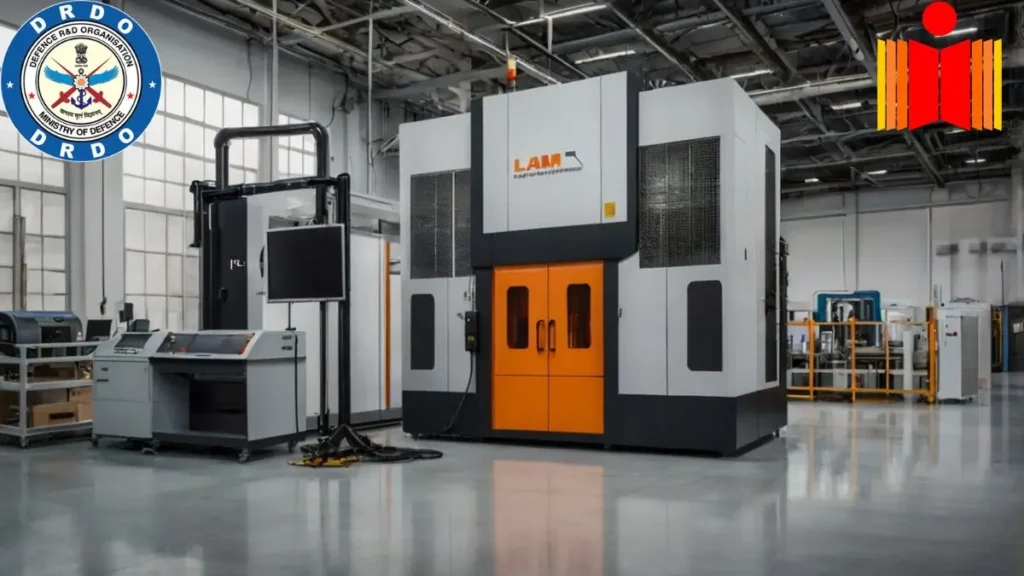In a significant milestone for India’s defense and aerospace industries, the Defence Research and Development Organisation (DRDO), in collaboration with the Indian Institute of Technology (IIT) Hyderabad, has introduced an advanced Large-Area Additive Manufacturing (LAAM) system. This cutting-edge technology in Large-Area Additive Manufacturing is expected to redefine the way critical metal components are designed and manufactured, offering enhanced efficiency, precision, and cost-effectiveness.
Table of Contents
Development in Large-Area Additive Manufacturing
Additive Manufacturing (AM), commonly known as 3D printing, has been making strides across various industries. The LAAM system developed by DRDO and IIT Hyderabad represents a breakthrough, particularly in producing large, complex metal structures that are vital for defense and aerospace applications. Traditional manufacturing processes often involve extensive material wastage, high costs, and longer production times. The newly developed LAAM system addresses these challenges by enabling layer-by-layer fabrication of intricate designs with minimal waste and maximum precision.
The Large-Area Additive Manufacturing system represents a pivotal shift in how we view traditional manufacturing methods, merging innovation with practicality. Utilizing Large-Area Additive Manufacturing, manufacturers can achieve unprecedented levels of customization and efficiency.
One of the key advantages of this system is its ability to manufacture lightweight yet highly durable components, making it ideal for applications in defense, aerospace, and space exploration. This capability is particularly crucial for the development of aircraft, missiles, and satellite components, where weight reduction without compromising strength is a major consideration.
The LAAM system enhances India’s capabilities in Large-Area Additive Manufacturing, making it easier to produce vital components domestically. By utilizing Large-Area Additive Manufacturing, the production of mission-critical components has never been more efficient.
Advancing India’s Self-Reliance in Defense Manufacturing
With advances in Large-Area Additive Manufacturing, industries can now produce parts that were once thought impossible with conventional methods. The versatility of Large-Area Additive Manufacturing extends beyond defense, impacting sectors like automotive and healthcare. The unveiling of the LAAM system aligns with India’s ‘Make in India’ and ‘Atmanirbhar Bharat’ initiatives, which aim to strengthen domestic manufacturing capabilities and reduce dependency on foreign suppliers. By integrating additive manufacturing into defense production, DRDO and IIT Hyderabad are fostering indigenous innovation, allowing India to develop critical technologies in-house rather than relying on imports.
This partnership significantly enhances India’s reputation in Large-Area Additive Manufacturing technologies.
Prof. B. S. Murty noted that Large-Area Additive Manufacturing is crucial for creating innovative designs that push the boundaries of traditional methods.
This advancement also enhances India’s strategic preparedness by ensuring a steady and reliable supply of essential components for defense applications. With the ability to rapidly prototype and produce mission-critical parts, the LAAM system minimizes lead times and facilitates quicker response to emerging defense needs.
India’s entry into Large-Area Additive Manufacturing underscores its commitment to advancing defense technology. Future developments in Large-Area Additive Manufacturing at DRDO and IIT Hyderabad promise to further refine production capabilities. As the Large-Area Additive Manufacturing initiative evolves, it is set to reshape how components are manufactured in various sectors.
Technical Advancements and Industrial Applications
The LAAM system employs advanced metal 3D printing techniques such as Directed Energy Deposition (DED) and Powder Bed Fusion (PBF), both of which are highly regarded for their ability to produce robust and high-performance metal parts. The system’s large-area capability allows for the fabrication of components that were previously limited by the size constraints of traditional AM machines.
Beyond defense and aerospace, this technology has potential applications in other high-tech industries such as automotive, healthcare, and energy. For instance, the medical sector could leverage LAAM to manufacture patient-specific implants and prosthetics, while the energy sector could utilize it for fabricating components used in power plants and renewable energy systems.
Collaboration Between DRDO & IIT Hyderabad
The collaboration between DRDO and IIT Hyderabad underscores the importance of academia-industry partnerships in driving technological innovation. IIT Hyderabad, known for its expertise in additive manufacturing and materials research, has played a crucial role in developing this advanced system. By combining DRDO’s extensive experience in defense technologies with IIT Hyderabad’s academic and research capabilities, the project has successfully delivered a high-impact solution for the nation’s defense needs.
Prof. B. S. Murty, Director of IIT Hyderabad, highlighted the significance of this partnership, stating that such collaborative efforts pave the way for groundbreaking advancements in manufacturing technologies. He emphasized that additive manufacturing is not just about improving efficiency but also about creating entirely new design possibilities that were previously unattainable using conventional methods.
Future Prospects & Global Competitiveness
The introduction of the LAAM system positions India at the forefront of global additive manufacturing advancements. Countries like the United States, Germany, and China have already made significant investments in metal 3D printing for defense applications. With this development, India joins the league of nations leveraging additive manufacturing to strengthen their defense capabilities.
Looking ahead, DRDO and IIT Hyderabad plan to further refine and expand the applications of the LAAM system. Future iterations could focus on scaling up production capacity, enhancing material options, and integrating artificial intelligence-driven design optimization techniques to further improve manufacturing efficiency.
Moreover, this initiative could attract investments and partnerships from both domestic and international defense and aerospace companies. As the technology matures, Indian industries could see significant cost reductions, increased customization options, and improved production agility.
Conclusion
The launch of the Large-Area Additive Manufacturing system by DRDO and IIT Hyderabad marks a transformative step in India’s defense and aerospace manufacturing landscape. This development not only strengthens India’s self-reliance in critical defense technologies but also opens up new possibilities for innovation and industrial growth.
By harnessing the power of additive manufacturing, India is set to revolutionize the way high-performance components are designed and produced, ensuring that the country remains at the cutting edge of global defense and aerospace advancements. The LAAM system stands as a testament to India’s growing expertise in advanced manufacturing, setting the stage for further technological breakthroughs in the years to come.
Original Source


